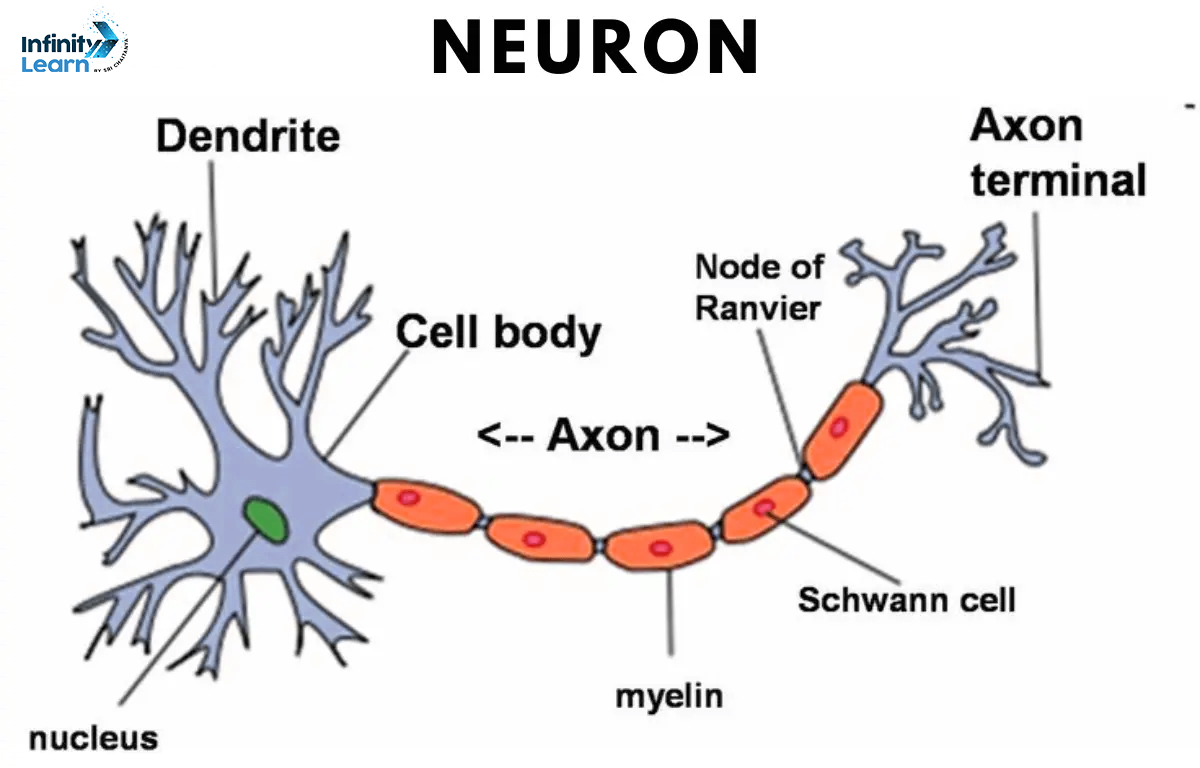Table of Contents
Neuron Diagram Class 9: The neuron is a fundamental component of the nervous system. It plays a vital role in transmitting signals throughout the body. Understanding the neuron diagram is essential for success in class 9 exams. Below is a labeled diagram with explanations to assist you in achieving top marks.
Definition of Neurons
Neurons are the fundamental units of the nervous system, responsible for transmitting and processing information. These specialized cells consist of three main parts: the cell body, dendrites, and an axon. Together, they form an intricate network throughout our body, enabling functions like thinking, perception, and bodily movements.
Neurons play a vital role in both the central nervous system, which includes the brain and spinal cord, and the peripheral nervous system, governing sensory experiences and motor abilities. Check for difference between Sensory and Motor Neurons
Studying neurons is crucial for understanding the complexities of the brain and how it influences our cognition and behavior. In humans, there are three primary types of neurons: sensory neurons, motor neurons, and interneurons, each serving specific functions in the nervous system.
Don’t Miss
- Animal Cell Diagram Class 9
- Difference Between Animal Cell and Plant Cell
- Difference Between Neuron and Neuroglia
- Most Easy and Scoring Chapters of CBSE Class 9 Science
- How To Score Full Marks In CBSE Class 9 Science Exam
Well Labeled Neuron Diagram Class 9

Neuron Diagram Class 9: Comprehensive Guide to Structure and Functions
Structure of Neurons:
- Neurons have three main parts: the cell body, dendrites, and axon.
- The cell body is like the command center of the neuron.
- Dendrites are like branches that receive messages from other neurons.
- The axon is a long, thin part that carries messages away from the cell body.
Functions of Neurons:
- Neurons help us sense things like touch, smell, taste, and sound.
- They also help us move by sending signals to our muscles.
- Neurons are responsible for our thoughts, feelings, and memories.
A neuron has several important parts:
- Dendrites: These receive signals from neighboring neurons. They have a branching structure to capture information effectively.
- Soma or Cell body: This is the neuron’s central region containing the nucleus and essential organelles. It processes information received from dendrites and decides on a response.
- Axon: This is a long projection from the soma, responsible for carrying electrical impulses away from the soma. It’s the main communication pathway between neurons.
- Nodes of Ranvier: These are small gaps along the axon where the myelin sheath is absent. They enhance signal transmission speed, crucial for swift responses.
- Synapses: These are at the ends of the axon and contain synaptic vesicles storing neurotransmitters. They facilitate smooth transfer of information between neurons, muscles, or glands.
- Schwann cells: Found in the peripheral nervous system, they support axons, maintain their structure, and aid in regeneration of damaged nerve fibers. They also produce the myelin sheath, which insulates the axon.
Benefits of Neuron Diagram for Class 9
Class 9 students gearing up for their exams should prioritize practicing the neuron diagram, as it holds paramount importance in the exam structure. This diagram serves as a fundamental cornerstone in understanding the complexities of the nervous system. By familiarizing themselves with its intricacies, students not only enhance their grasp of biological concepts but also develop critical analytical skills necessary for success in the examination
- Understanding the Brain: Neuron diagrams help class 9 students understand how the brain works by showing the structure and connections of nerve cells.
- Visual Learning: Neuron diagrams provide visual aids that make it easier for class 9 students to grasp complex concepts about the nervous system.
- Memory Aid: Drawing neuron diagrams helps reinforce learning and memory retention, making it easier for class 9 students to recall information during exams.
- Critical Thinking: Practicing neuron diagrams encourages class 9 students to think critically about the functions and interactions of different parts of the nervous system.
- Practical Application: Learning neuron diagrams prepares class 9 students for future studies in biology and related fields, where understanding the nervous system is essential.
FAQs on Neuron Diagram Class 9 Biology
What is neuron in biology class 9?
In biology class 9, a neuron refers to a specialized cell in the nervous system responsible for transmitting information throughout the body.
What is a neuron diagram?
A neuron diagram is a visual representation of the structure of a neuron, typically illustrating its various components such as the cell body, dendrites, axon, and synaptic terminals.
What does a neuron look like class 9 chapter 6?
In class 9, chapter 6, a neuron typically appears as a cell with a cell body, multiple dendrites branching out, and a single axon extending from the cell body.
What is neuron structure in NCERT?
The neuron structure described in NCERT (National Council of Educational Research and Training) typically includes the cell body, dendrites (receiving ends), axon (transmitting end), and synaptic terminals (connections with other neurons).
Classify the Neurons based on Polarity?
Neurons can be classified based on polarity into three types: unipolar neurons, bipolar neurons, and multipolar neurons.





